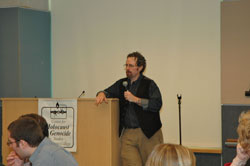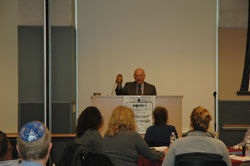- About Ramapo
- Academics
- Admissions & Aid
- Student Life
- Athletics
- Alumni
- Arts & Community
- Quick Links
- Apply
- Visit
- Give
Reading and Writing in Teaching About the Holocaust and Genocide Focus of Workshop for Teachers
(PDF) (DOC) (JPG)May 17, 2011

Prof. Edward Shannon
(MAHWAH, NJ) – A group of more than 80 teachers participated in the Emil Gumpert Teachers’ Workshop held by the Center for Holocaust and Genocide Studies in cooperation with the New Jersey State Commission on Holocaust Education on May 17 at Ramapo College. The workshop was designed to hone participants’ skills in using reading and writing to teach about the Holocaust and genocide.
Two experienced instructors of writing, Erica Kaufman and Dr. Jennifer Lemberg, modeled an intense array of exercises in which workshop participants engaged in discussing and presenting various types of writing assignments (focused writing, process writing, loop writing). To a large degree, it was a significant reversal of their usual role in the classroom. Judging from the discussion that accompanied each exercise, one would have to conclude that the results were beneficial, and participating teachers would now have new ways to engage their students.

Mr. Erwin Ganz
During lunch, participants experienced an enlightening and entertaining PowerPoint presentation on “Comics and Graphic Novels in Teaching about the Holocaust and Genocide” by Dr. Edward Shannon, Professor of Literature at Ramapo College. He showed how the graphic novel developed from the coded imagery and text produced by outsider creators, most of whom were Jewish. Although some even began to address issues related to the Holocaust in the 1950s and 1960s, it was not until Art Spiegelman’s Maus: A Survivor’s Tale in 1986 that the destruction of the Jews in World War II was for the first time depicted through the fate of one victim (Spiegelman’s father Vladek) in comic-strip fashion. As Ed Shannon pointed out, in depicting Jews as mice, while Germans are represented as cats, while other groups are represented variously (Americans as dogs, Poles as pigs and French as frogs and the British as fish), Spiegelman played with his readers’ sense of irony and self-mockery.
The final presentation of the day was by a child survivor of Nazi rule in Germany, Mr. Erwin Ganz of Warren, New Jersey. With great eloquence, Mr. Ganz related how in 1933 at the age of three, he and his family were forced to relocate to Bernkastel Koos, Germany. Until April 1939, when the family emigrated and re-settled in Newark, his days were spent mainly traveling to a Jewish school some 35 miles way and suffering the taunts and attacks of non-Jewish children. Judging by the evaluations completed after the event, participants were deeply impressed by Mr. Ganz’s depiction of the life of a young Jewish boy in Nazi Germany.
E-News Archives
| 2023 | 2022 | 2021 | 2019 | 2018 | 2017 | 2016 | 2015 | 2014 | 2013 | 2012 | 2011 | 2010 | 2009 | 2008 | 2007 |Copyright ©2024 Ramapo College Of New Jersey. Statements And Policies. Contact Webmaster.

Follow Us!